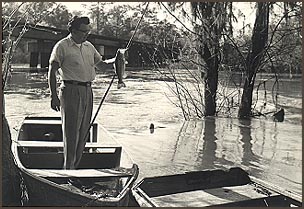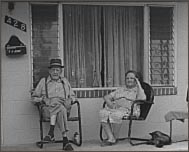
Joe I. Davis, wife Florence Dumpsy Davis, and three children.
Joe I. Davis,
Boatbuilder?
by Frank D. Howard
February 12, 1997
Joseph Irvin Davis, 1887-1982, was the seventh child in a family with 13 children. Being from a family involved in the naval stores trade he and his brothers all began their careers working in one end or the other of the wood products line. Shortly after the turn of the century he was listed as "cabinet maker." In reality, he was one of those true jack-of-all-trades as he was a builder of houses, a Marshall, a Police Chief, a Florida Conservation Officer (in the first group trained!), a store owner, a wheelwright (wagon wheels), sawmill owner/operator, and into many other less exciting short careers. Throughout all these he was also highly respected and sought out for his ability in building a local type of fishing boat for use in the rivers and lakes of Florida's Big Bend area.
Mr. Davis' specialty was the larger variety of the boat known locally as a bateau or more simply, a proper "fishing boat." The usual boat was from 14 to 16 feet long with scow type bow and a plumb stern. These boats were always planked athwart the bottom in the manner of a garvey. Some of them carried so little bottom rocker they appeared flat while others had as much rocker as some coastal sailing sharpies. In the best of them, the gunwales were each made from a single plank and displayed considerable flare. The only moulds were in the form of a center pair of bulkheads which were sealed to the hull and then covered with a seat. A portion of the seat was hinged so as to form an opening into the area between these solid frames. A hole the size of a cork fishing float was let into the bottom making the area between those bulkheads a live well for the fisherman's catch.
While most of the differences between Mr. Davis' boats and others of his day were too subtle to notice except to the most avid Brim or Shellcracker fisherman, two of those differences were readily apparent. Although he built boats in sizes from 12 to 30 feet long he is best known for those in the 18 to 24 feet length. Old timers told me the quickest way to tell a Joe Davis boat was by "the gunnel thickness." It seems he favored Juniper wood planed to a thickness of about 5/8th inches! Only in his larger boats did he go with thicker wood. He always used only Juniper and/or Cypress for his boats.
By far the most apparent feature of many of his larger boats was a built in "hog" in the bottom! Instead of the usual Garvey style rockered bottoms, the boat looked much like someone had joined two such boats, stern to bow, producing a slight "w" shaped bottom. While this hogged area seems to be nearly centered in some of the boats, I recall a pair of 24 foot boats in which the hogged area was about 40% back from the bow. The rocker in the forward portion was not symmetrical but was longer from the hog and rose rather quickly at the bow.
It was while observing this pair of newly built boats (winter '40 - '41) I had the opportunity to overhear an answer to the "why th' swaybacked hog" question. As he was not one to talk and work, Mr. Davis usually answered such questions with a single sentence. But this time he stopped and waxed on for a considerable length of time. His explanation began with a statement of intended use for the pair of boats.
They would only be in load for about 10% of their traveling time. The boats would be in the quiet waters of the numerous and interconnected lakes of the region. Therefore he was building a boat which would be able to lift its bow free of the water at very low speeds. He would then have a boat of much shorter waterline length "carrying" the bow portion of itself as a load. The sway, or asymmetry of the bow portion of the bottom presented a quick lifting surface with a short run followed by, on the remaining surface in front of the hog, a surface now parallel to the surface of the water. Once the boat gains the small speed necessary to do so the bottom forward of the hog lifts clear of the water.
Perhaps we should be reminded of how these fishing boats were powered at that time. Paddles. One or two paddlers in the small boats but as many as six or eight in the larger ones. Outboard engines were available but not many could afford them. This writer has been a passenger (paddler!) in arrays of boats moving up river in tow. One such involved nine boats of various size being towed by a small boat equipped with all of about 6 Hp. Another such an array involved four such boats where the lead boat was equipped with Mr. Davis' own 1 1/2 Hp Elto (this motor exists today in an antique collection). The only real speed came when each boat headed to its own fishing spot (or back down river) and some six or more youthful paddlers would begin to show off in the larger boats.
Did this "design" feature really work. This writer did paddle in those boats and did witness the bow portion lift clear of the water. What was not noticed was a distinct difference in the effort needed to bring one boat versus the other up to speed. Was this due to the (then!) youthfulness and indifference of the observer or to faulty design theory?

|
|
1958 fishing photo shows two boats similar to those built by Joe Davis. |
One of Mr. Davis' more unusual houseboats (observed after it was much rebuilt and in a bad state of decay) was built around 1932. Perhaps it was only a one-of-a-kind trial but it certainly was different. The hulls were an asymmetrical pair in that each hull had more draft and less flare on it's outboard side than on the inboard side. His one sentence explanation was to the effect it was more stable but too difficult to build. The boat appeared to be of about 19' waterline and about 3' beam at the bottom of each hull. Judging only from the stains left by its waterline the inside of each hull drew about 2 1/2" and the outside about 5". (If only it had been measured!) But then he was a man not given to production line work and many of his boats were finished out as one of a kind custom jobs!
 |
|
Some of the boat detail can be seen in this 1958 hand-colored black and white photo. |
Although cypress is well known as a wood that swells smoothly and readily seals bottom seams it is also a wood which doubles in weight when waterlogged. Mr. Davis preferred the more difficult to find juniper. He would always try to keep a few stacks of juniper flitches stored somewhere. A man sometimes too generous, he was known to give a pair of flitches to someone who could not afford to have a boat built. In planking the bottom with juniper he would plane a slight "V" crown in the forward facing edge of each plank. Before placing the plank in place it was rolled sharply across a metal roller to flatten the crown. This V crown was to then swell into the flat face of the next plank as the boat wet out giving a water tight joint. Rarely was there a need to caulk these seans. The bottom planks to chine were caulked while building utilizing whatever light twine he had set in anything from fine pitch, roofing tar or even putty.
While there may have been others I am aware of only two of the more traditional plank on frame boats by Mr. Davis. One was built as a 24 foot carvel planked river tug/log herder in 1946. The other was a 28 foot Vee bottom boat built in 1958 with a relative purely for fun of building something different. The bottom was fastened with trunnels whittled from the heartwood of southern yellow pine. I had the pleasure (?) of whittling and sizing a large number of these little devices. The juniper bottom was of planks which varied from 1" to 2 1/2" in thickness. Framing was a compromise between the builders in that some sawn live oak was used. The cabin and its furnishings were all of cypress and juniper. The power was a made-up conversion of a Chevrolet truck engine.
As local production of boats speeded up after World War II there little need for his boats. His boats were for paddlers and the explosion of larger better outboard motors meant only the old-timers were asking him for new boats. By 1950 he was rarely asked to build a boat.

|
|
Joe and Dumpsy Davis, 1979. |
His last boat was built after he was in his eighties. Although it was only 12 foot long and not as well finished as others of the past it did exhibit many of those features which identified it as a Joe Davis boat. He had used it for an occasional fishing trip on a small creek a few yards from his house. As was the custom in the past when leaving such a boat for an extended period, he sank it near the creek bank leaving it tethered to a tree after his last trip told him he was too frail to continue such. He was then in his nineties.
After his death a local historian wanted to preserve this last boat. Be reminded that in Mr. Davis' time there were many hundreds of such boats in the region. There were always several boats at any little known, or most certainly the well known, boat "landings." If one went to a landing to use his own boat and it wasn't there one simply used another as both boats would be returned at the end of the fishing day. That was then and this was 1984!
By this time, one's boat must be locked up. My brother and I went to the creek to recover this last boat for the historian only to find large truck tracks leading to the creek and a badly mangled boat in two parts where some thief had placed a chain around the boat near its bow and attempted to pull it, water and all, from the creek. If only he had known that all he had to do was jostle the boat back and forth to slosh some water out and then bail he would have had a fine dry boat to steal.
